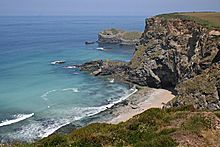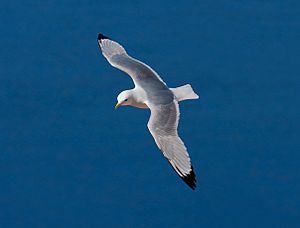Godrevy Head to St Agnes facts for kids
| Site of Special Scientific Interest | |

Bassett's Cove, within the SSSI
|
|
| Area of Search | Cornwall |
|---|---|
| Coordinates | 50°14′55″N 5°19′07″W / 50.2486°N 5.3187°W |
| Interest | Biological/Geological |
| Area | 627.4 hectares (6.3 km2; 2.4 sq mi) |
| Notification | 1951 |
Godrevy Head to St Agnes is a special coastal area in north Cornwall, England. It's known as a Site of Special Scientific Interest (SSSI) because of its amazing plants, animals, and unique rocks. You can find many rare plant species here, along with lots of seabirds that come to breed.
Contents
What Makes This Place Special?
This protected area covers about 627 hectares (that's like 1,550 football fields!). It was first recognized as special in 1951. The site stretches along the north Cornwall coast, facing the Celtic Sea in the Atlantic Ocean.
It starts at Godrevy Head in the west and goes for about 20 kilometers (12 miles) to the north-east. It passes through places like Portreath and Porthtowan, ending just past St Agnes Head.
The famous South West Coast Path runs right through this SSSI. A big part of this coastline is looked after by the National Trust, which helps protect natural and historic places. Also, large sections of this area are part of the Cornwall Area of Outstanding Natural Beauty (AONB). This means the landscape is so beautiful it's protected!
The Rocks Beneath Your Feet
The land at Godrevy Head to St Agnes is mostly made of old rocks. These rocks are called Devonian sandstones and shales. They formed millions of years ago! Near St Agnes, you'll find a different type of rock called Grampound grit. These different rock types help create the varied landscape you see today.
Amazing Plants and Animals
This coastal area has many different types of natural homes, called habitats. These include tall cliffs, grassy areas near the sea, heathland (open land with small shrubs), sand dunes, and scrubland (areas with bushes and small trees). These habitats are perfect for many plant species and large groups of seabirds. Because of its special plants, this site is also a Special Area of Conservation.
Unique Plants of the Coast
The entire Godrevy Head to St Agnes SSSI is also an "Important Plant Area." This means it's super important for plants!
In the grassy areas near the sea, you can find some very rare plants. These include shore dock and wild asparagus. There's also a rare plant called carrot-broomrape. It's a "parasite," which means it grows on and gets its food from another plant, in this case, wild carrot.
Among the common plants in the heathland, you might spot the rare Cornish eyebright, Dorset heath, and hairy greenweed. There's also the pale dog-violet, which is generally rare.
The sand dunes, especially around the Godrevy Towans, are home to the rare slender bird's-foot trefoil. In the chalky grassland parts of the dunes, you can find the rare Portland spurge. There's also a large group of spotted cat's-ear plants, which are nationally rare.
Wildlife and Their Habitats
This site is a buzzing place for insects! You can find 25 different types of butterfly and 15 kinds of dragonfly and damselfly. Some of these are nationally scarce, like the silver-studded blue butterfly and the blue-tailed damselfly.
In the intertidal zone (the area between high and low tide), you can find scarlet and gold star coral. These are rare for the Cornish coast! Grey seals also use the hidden sea caves along the cliffs as safe places to have their babies.
The cliffs and small islands offshore are very important breeding spots for many different seabirds. This area has the largest group of black-legged kittiwakes breeding in Cornwall. Between 1,000 and 5,000 of these birds have been counted here!
Images for kids





